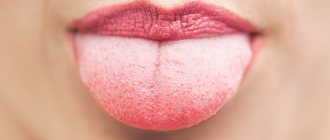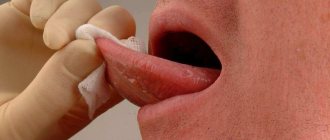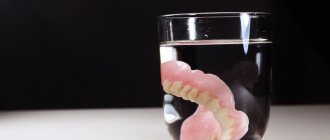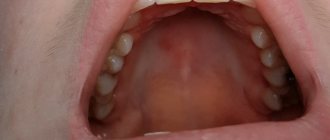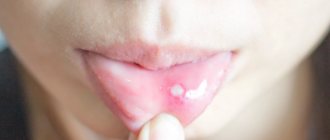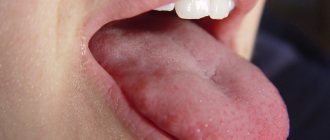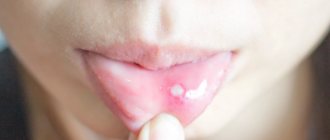When red bumps appear on the tongue, at the tip or closer to the throat, you need to find out what this phenomenon is. Such rashes often bother not only adults, but also children. And since they arise for a wide variety of reasons , it is necessary to figure out whether pimples pose a danger and choose the optimal method of treatment.
Causes
There are several reasons, and among them there are quite serious diseases.
Enlarged papillae
Enlarged circumvallate papillae or taste buds are the most common cause of bumps on the root of the tongue.
Do you often or periodically notice small red or white bumps on the surface of the tongue, the tip or at its base? Don't worry as they are not that dangerous.
Irritation of the tongue papillae can cause this problem. Keep in mind that at the back of the tongue there are so-called circumvallate papillae, which are larger in size than those located in the front and center. And when they increase, they become very noticeable to the owner.
Here are some contributing factors:
- Spicy food. It is one of the most common reasons that cause irritation. People who prefer these types of foods sometimes receive small bumps on their tongue in return.
- Allergy. “Allergic reactions cause swelling of the taste buds because they stimulate the activity of white blood cells.” [medlicker.com]. Foods and medications can cause this reaction. Fortunately, not all people are allergic to certain foods.
- Some infections that occur in humans can contribute to irritation of the taste buds. These include sexually transmitted diseases (STDs) such as herpes simplex type 1 (HSV-1), syphilis and human papillomavirus (HPV).
Lumps at the base of the tongue due to an STD
Other causes of papillary irritation may include smoking, gastroesophageal reflux disease, or heartburn.
Note: Some people naturally have larger taste buds than others, which means they are more noticeable. Plus, they can increase, including even with slight irritation.
Injury
Oral surgery and rough brushing of the tongue can cause injury. Although the problem is expected to go away on its own, failure to maintain normal oral hygiene can worsen the condition of the bumps due to injury.
Warts caused by HPV
Warts caused by the human papillomavirus (HPV) can also appear on the tongue. The infection can be transmitted to the mouth by licking infected parts of the body or placing a finger containing the virus in the mouth.
Unlike genital warts, which appear on mucous membranes usually in the genital area, oral warts tend to look a little different: colorless, wrinkled, or with a sharp tip. This will help you identify them. However, an examination should be performed to clearly distinguish these bumps on the back of the tongue from others, if present.
Kawasaki disease - red bumps on the tongue in children
This disease can cause a variety of symptoms at different stages. Signs are seen not only in or around the mouth, but also on the skin, including the palms of the hands and soles of the feet.
The reason is unknown. However, acute symptoms may persist for several weeks after infection and help identify the disease. Here are the first main signs of Kawasaki disease:
- high body temperature;
- red dry lips with cracks;
- enlarged lymph nodes in the neck;
- swollen tongue;
- red, small bumps (pimples) on the tongue that resemble strawberries;
- A red rash appears on the skin in the genital area, then on the face, arms and legs.
Swollen sores
A swollen sore is usually a sign of stomatitis.
Most people experience the formation of mouth sores at least once in their lives. Although their appearance at the root of the tongue is not common. They usually start out as small, painful red spots. When these spots develop, they turn into non-healing ulcers.
The most common cause of this problem is stomatitis.
The reasons for the development of tongue ulcers are not precisely known, but doctors believe and associate their occurrence with several factors, namely: emotional stress, immune system disorders, hormonal imbalances and celiac disease.
The condition of such wounds worsens if they become infected. You should also avoid spicy and salty foods until they pass.
Other problems that bumps can cause
Oral fibroma is a benign growth of tissue that can also occur on the tongue. Most often this is a single node, but in rare cases there may be more.
Thrush is a development of yeast fungus that often initially appears at the base of the tongue. Although this is essentially a light plaque, when it accumulates it can resemble a bump.
Leukoplakia is keratinization and desquamation of the skin, which also rises to some extent above the surface of the tongue. It usually occurs on the sides of this organ, including closer to the base.
Classification of pimples
There are many types of pimples on the tongue. They are classified according to four characteristics: color, location, size and pain.
Color
Growths that do not differ in color from the tongue and are painless are warts or condylomas.
Natural, red-pink.- When red or bloody pimples , such as in the photo, their cause may be a burn, herpes, or allergic reactions.
- Red bumps that turn black are associated with mechanical damage or injury. The black color appears due to microhemorrhage.
Location
- On the tip of the tongue. Often this place is subject to injury and various damage, which can cause inflammation. First, a small bump appears on the end of the tongue, then a painful red or black pimple.
- On the side. In most cases, pimples are localized in this place, as a result of stomatitis, as well as benign neoplasms.
- At the larynx. Red pimples on the tongue closer to the throat often turn out to be benign formations: condylomas, warts.
- Under the tongue. Lumps and bumps in this place (near the frenulum) in both adults and children indicate inflammatory processes: tonsillitis, sore throat, pharyngitis.
The size of the formations can be large, medium or small.
Presence of pain
Pimples resulting from injuries, burns, inflammatory and infectious lesions of the oral cavity and larynx. Pain manifests itself when touching the tubercles; it hurts a person to speak or swallow.
Painful sensations.- There is no pain. In most cases, painlessness is characteristic of warts and condylomas. Benign neoplasms often affect the root of the tongue; you can see how it looks with pimples in the photo.
Could bumps on the tongue be a sign of cancer?
Swellings in the form of persistent sores that do not heal, are accompanied by a numb tongue, sore throat or hoarseness, and also create difficulty chewing and swallowing - may indicate oral cancer.
Other symptoms of mouth cancer include:
- falling out or loose teeth;
- tonsillitis;
- white or red sore-like bumps inside the mouth, such as on the gums;
- jaw pain;
- may sometimes be accompanied by an unpleasant odor.
Symptoms of oral cancer must be diagnosed and evaluated by a dentist. This is critical to avoid making the wrong decision regarding a symptom such as painless bumps on the back of the tongue with sores that take a long time to heal.
Diagnostics
As we found out, bumps in the oral cavity can have different etiologies. Therefore, the purpose of tests will depend on the expected diagnosis. Before conducting laboratory tests, a specialist conducts a detailed examination of the tumor.
Usually, doctors always recommend doing a general blood and urine test. This will help identify the presence of inflammation.
If infectious diseases are suspected (herpes, papillomatosis, stomatitis), PCR diagnostics may be required.
For benign and malignant tumors, a biopsy is prescribed. A small piece of tissue is taken from the cone and sent for microscopy. Based on the results of the study, one can judge the type of neoplasm.
Red bumps
Red bumps on the tip, sides or back of the tongue may have specific causes or factors that also cause this redness. For example, ulcers and Kawasaki disease are responsible for red bumps on the surface of the tongue.
Other causes of redness include inflammatory infections such as colds and flu. Taste bud irritation and repetitive trauma to the tongue are other possible triggers.
Have you previously been diagnosed with allergies or herpes? If you constantly get painful red pimples or large bumps at the root of the tongue, contact an ENT specialist or dentist as soon as possible.
Congenital pathologies
Sometimes neoplasms on the root of the tongue can be congenital. They appear as a result of developmental disorders of the fetus during the intrauterine period. Most often, such tumors are diagnosed in childhood. Let's take a closer look at congenital pathologies of the tongue:
- Hemangioma. This is a tumor consisting of blood cells. Its etiology is associated with a violation of embryogenesis. More often girls suffer from hemangioma; the disease is detected either at birth or in early childhood. The neoplasm looks like a red spot or a blue-purple lump. When the tumor is injured, heavy bleeding occurs.
- Lymphangioma. The tumor grows from lymphatic vessels. The rashes look like warts. Often the tongue is greatly enlarged in size. Lymphangioma is diagnosed in childhood. The tumor often becomes inflamed due to injury from hard food or teeth.
- Struma of the root of the tongue. This is a very rare disease. If embryonic development is disrupted, thyroid cells may enter the developing tongue. This is the cause of the pathology. The struma consists of thyroid tissue. It looks like a nodule under the tongue up to 3 cm in size. This disease is otherwise called goiter of the tongue. Clinically, it usually manifests itself during puberty. It becomes difficult for the child to swallow and speak. This tumor must be removed surgically, as it is prone to malignant degeneration.
Large white bumps
Everyone should be concerned if they notice the presence of large pimples or bumps in the mouth. Especially if they have signs of bleeding and are accompanied by constant pain. Such growths in the mouth, the symptoms of which last longer than a week, can be a dangerous sign of oral health.
White bumps on the base of the tongue may be ulcers if they cause discomfort or pain. If they are painless and flat, you need to go for a diagnosis of oral cancer, because this is one of its signs. Early signs of cancer can be mistaken for dental problems - it is important to rule out the wrong ones.
Preventive measures
Simple preventative measures will prevent the onset of the disease. Basic rules of behavior and hygiene:
- Fruits and vegetables should always be washed before consumption.
- Food should not be excessively hot, cold, spicy or rough.
- The chewing process should be slow, which will prevent tongue biting.
- Personal hygiene should be observed: dental and oral care.
- It is necessary to have individual cutlery and a toothbrush.
- The brush should be renewed monthly. Change immediately after an illness.
- Regular visits to the dentist are recommended. It is necessary to treat diseases of the teeth and oral cavity in a timely manner, remove tartar and plaque, because these are the main sources of infection in the mouth.
- It is necessary to maintain adequate physical activity, which will increase immunity and the condition of the entire body.
Any pimple, growth or tubercle on the mucous membrane, both in an adult and in a child, requires close attention. You should not treat the bumps yourself; only a doctor can do this.
You should not pierce or try to squeeze out pimples on the mucous membrane; such actions can lead to negative consequences: the growth of foci of inflammation, the appearance of open wounds as a result of injuries.
The best thing a person can do if they have bumps on their tongue is to see a dentist or therapist. Such a decision will speed up recovery and prevent possible complications.
Treatment
Most problems associated with bumps on the tongue can go away on their own. However, treatment is required if symptoms such as pain and bleeding occur.
Taking antibiotics
Antibiotics are used to fight infection caused by free-living microorganisms that increase inflammation. It is necessary to use antibiotics that are effective against specific bacteria, so it is advisable that they be prescribed by a doctor.
Saline
A diluted saline solution helps fight germs in the mouth, therefore promoting faster healing of the bumps.
Surgical intervention
This treatment may be needed to remove fibroids (benign lumps) or cancer cells and prevent them from spreading further.
What to do if there are any?
If any strange formations appear on the tongue, the most reasonable solution would be to show them to the doctor. If there is a suspicion that the symptoms are associated with throat diseases, you need to contact an otolaryngologist - ENT, and in other cases you should consult a dentist or therapist. The doctor will be able to adequately assess the situation and take the necessary actions to make the correct diagnosis:
- Conduct a blood test.
- Scrap the tongue and conduct a microscopic or bacteriological examination.
- Take tissue for histological examination.
Only after establishing the correct diagnosis will a specialist be able to select a full-fledged treatment, if necessary. You shouldn’t smear the tumors on your tongue with anything on your own, much less try to get rid of them mechanically.
Home and folk remedies and methods
Depending on other associated symptoms in the mouth and throat, recommendations can be made to eliminate them.
Regular oral cleaning
Suffering from any kind of tongue problem cannot justify stopping the practice of hygiene procedures. On the contrary, regular cleaning of the oral cavity is even more necessary to fight microorganisms that accumulate there. Proper brushing will also help end bad breath.
Remedies for ulcers and wounds
Mouth ulcers are accompanied by pain. Therefore, hot and spicy foods should be avoided. Most meals for people with this problem should consist of liquid foods and drinks until the sores improve or are completely healed. Some of the tools will be useful to apply:
- Clove or coconut oil for applying to sores.
- A solution of aloe juice and honey for periodic mouth rinsing.
- A sage solution to rinse your mouth with once a day.
A warm saline solution can be used to relieve pain, but salt should not be placed directly on the sores. If this does not help, then you need to see a doctor so that he can prescribe a pain reliever.
